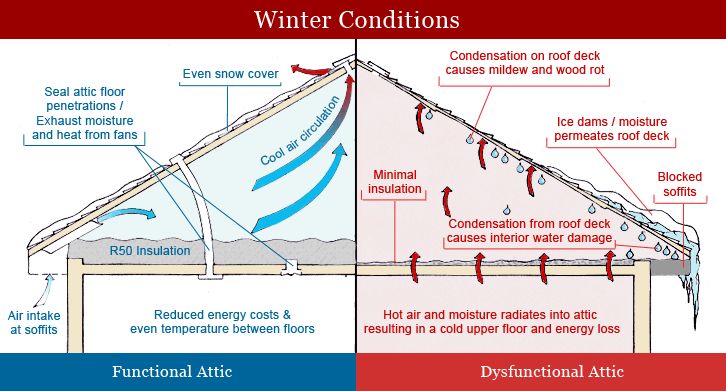Condensation: How It Becomes a Roof Problem and Ways to Address It

What Causes Condensation?
Air is either warm or cold. Condensation begins when the warm air from inside of your home rises and finds its way up (into your roof structure), mixing up with the outside air with a cooler temperature. As they meet up and the air continues to cool, the air loses its capacity to hold moisture and becomes saturated. And as a result, the moisture it holds is released in the form of droplets of water, thus completing the process of condensation and results in leaking.
Roof Condensation is most common in the cold months especially in winter since it is when the air temperature dramatically drops which means it is also during this season when use of your home’s heating system is greatest, causing the air from the inside of your home warmer and we already know what happens when these two meet.
Although most recurrent during cold seasons, condensation on your roof can be an all year round problem. Other sources of heat inside your home include daily activities like cooking, showering or bathing and the use of common home appliances like dishwashers, dryers, humidifiers and others.
What are the Signs?
Because condensation is commonly unnoticed for a long period of time, homeowners discover the problem when it has already caused too much damage. The good thing is, there are warning signs. You can use your windows and skylights as a reference to the humidity level inside your house since condensation is most visible in glass. You may also want to check for water stains on the ceiling, although these may show at a later stage of the problem. Droplets of water on the glass areas of your home, however, is an early sign and is an indication that it is time to have professionals check the less visited parts of your house like your ceiling and roof attic before the excess indoor humidity causes huge damage.
Can We Prevent It?
Since what starts condensation is the presence of both cool and warm air, it may sound like it’s something that we cannot stop from happening. However, there are steps that we can take to make condensation more manageable and here are some of them:
- Proper Ventilation. It is basically allowing escape of the air from inside your home. So instead of the warm air rising up to your roof, you can let it out through various ventilation systems in your house. Opening your windows when it is not too cold outside is a great way for ventilation.
When it comes to ventilation, you may want to focus on the areas of your home that produce the most heat like your utility room, your kitchen and your bathroom. Be sure to get a suitable exhaust fan for your kitchen. If you are just planning on building your home, you may want to have windows in these areas of your house to allow proper ventilation. In addition, fans will also be of great contribution to air circulation.
Aside from the mentioned regions of your home, it is of course essential to have adequate ventilation in your roof structure since we have already learned that warm air tends to rise. It would help to have additional roof vents, such as box vents, turbine vents and ridge vents which allow the warm air to escape the attic space, thus reducing condensation issues.
- Adequate Insulation. With issues concerning home insulation, thermal insulation is used to reduce and slow heat loss or gain by providing a barrier between areas that have remarkably different temperatures. If properly installed, these membranes help maintain a consistent and uniform temperature in different areas of your home, diminishing condensation. And again, your attic, being the escape destination of warm air from inside of your home, demands quality insulation.
- Vapor Barriers Installation. These are layers that are designed to hold moisture. They are used to prevent moisture from passing through vulnerable materials such as wood or insulation, likewise resisting its spread to different regions of your home like your ceiling and your roof structure. Although the installation of these barriers solves condensation issues without requiring major renovation on your roof, they need to be taken down during the summer to prevent them from causing worse roof problems.
Solving condensation problems may be different from one home to another. Important factors also need to be considered when addressing these issues, such as the climate. A fix that may be effective during the summer may no longer work during the colder seasons, and vise versa. It is imperative to have your roof inspected regularly especially prior to season change.
To make sure that you come up with the best solution for condensation and other roofing problems, request for professionals to do an assessment on your roof. All Weather Exteriors is a roofing company that is expert in the field. Our team will help you fix your problem by giving the best recommendations for all your roofing needs. For all your inquiries, you may give us a call at (204) 510-2959 or you may send us an email info@allweatherexteriors.ca and we’ll be happy to assist you!
Photo Credits: www.agassizroofing.com

Leave a Reply
You must be logged in to post a comment.